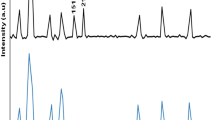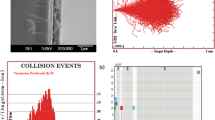Abstract
In this study, effects of Ni7+ beam irradiation on structural and optical properties of cadmium oxide thin films deposited on indium tin oxide (ITO) coated glass substrates using sol-gel spin coating technique have been reported. Structural properties of irradiated films (fluence 3 × 1012 ions/cm2) have been studied by glancing angle X-ray diffraction (GAXRD). The films exhibit cubic crystal structure and a high degree of crystallinity. UV-Visible absorption spectra reveal that Ni7+ beam irradiation causes an increase in blueshift of absorption edge for CdO pristine films, leading to enhancement in band gap energy as indicated by Tauc’s plot studies.
Access provided by CONRICYT-eBooks. Download conference paper PDF
Similar content being viewed by others
Keywords
1 Introduction
Transparent conducting oxide (TCO) thin films , such as indium oxide, tin oxide, zinc oxide, and cadmium oxide, have assumed great importance due to their high optical transmittance in the visible region, as well as superior electrical properties [1, 2]. These films find interesting applications in devices such as gas sensors, phototransistors, solar cells , transparent conducting electrodes and surface acoustic wave devices [3, 4]. In recent years, there has been a rising interest in the development of cadmium oxide based structures, which besides the merits of a good TCO also possesses an optimum band gap of 2.3 eV. For deposition of CdO thin films, we have used sol-gel technique based spin coating method. This method is a low cost atmospheric process easily adaptable to industrial use. The key to sol-gel method is in preparation of a stable solution for deposition of thin films. Irradiation of these films by an ion beam radiation induces damages which are material dependent and are expected to change the structural and optical properties of such metal oxide films. The main ingredient of metal oxide films is oxygen and it is highly vulnerable when exposed to ion beam radiation. Therefore, it will be of scientific and technological interest to investigate the effects of ion beam irradiation on CdO thin films.
The CdO thin films were irradiated by 100 meV Ni+7 ions using the 15UD Pelletron Accelerator facility at Inter University Accelerator Centre (IUAC), New Delhi. The Electronic energy loss (Se) and nuclear energy loss (Sn) was estimated from SRIM & TRIM simulations. The focused ion beam was scanned over an area of 1 cm2 with a fluence of 3 × 1012 ions/cm2 and the beam current was kept constant 1 pnA (particles nanoampere). In this study, modifications in structural and optical properties, expected mainly due to the electronic excitation induced by swift heavy ion (SHI) irradiation, were investigated.
2 Experimental Details
The precursor material used for sol preparation was cadmium acetate dihydrate, Cd(CH3COO)2 · 2H2O (purity grade 99.99 %). 2-methoxyethanol and monoethanolamine (both procured from Merck chemicals, India) were used as the solvent and stabilizer, respectively. The cadmium precursor solution was prepared by dissolving cadmium acetate dehydrate in 2-methoxyethanol so as to achieve an optimum concentration of 0.2 mol/l. The solution was magnetically stirred for 120 min resulting in a transparent and clear precursor, which was further related for 48 h. An important advantage of this method is that it yields stable solutions, while requiring no heating or long mixing times during preparation of solutions.
The film was deposited on glass substrate previously cleaned using organic solvents and ultrasonic agitator. The substrate was degreased by agitating first in petroleum ether for 15 min, then in acetone for 10 min and finally in methanol for 10 min using an ultrasonic agitator. The substrate was washed thoroughly using deionized water. Finally, substrate was dried for 20 min in a clean and dust free oven maintained at 80 °C. The sol was coated on the surface of substrate, with the substrate holder of spin coating unit rotating at a fixed speed of about 3000 rpm for duration of 25 s. The coated films were first dried at 120 °C for 12 min and then fired in air for 25 min in a tubular furnace maintained at 500 °C. Preparation of sol and deposition of films was carried out under approximately identical laboratory conditions. The films obtained were smooth and homogeneous. Films of higher thicknesses were obtained by repeating the process of coating and drying [5].
3 Results and Discussion
The structural analysis of 100 meV Ni7+ ion irradiated films was carried out using XRD technique. Pristine GAXRD patterns (Fig. 1) reveal three prominent peaks [(111), (200) and (220)] corresponding to the cubic structure of CdO (JCPDS-097512). From Fig. 1, it is observed that intensity of diffraction peaks increases for the films irradiated at 3 × 1012 ions/cm2 fluence, with respect to pristine films. The increase in peak intensity is an indicator of improvement in crystallinity of CdO thin films . The structural modifications induced by SHI irradiation can be explained by total energy deposited in electronic excitations or ionizations in the films by energetic ions. The imparted energy of the incoming ions in these films at higher fluence might result in overlapping of tracks to cause lattice disordering inside large grains. This is due to the excess of cadmium resulting from dissociation of CdO during evaporation. The absorption spectra of films irradiated 3 × 1012 ions/cm2 and pristine films have been shown in Fig. 2 (Table 1).
The graphs suggest that there is no significant change in band edge after irradiation but absorption increases in the visible region. This implies that the basic crystal structure does not change. In other words, the lattice is not amorphized, since this structural transformation generally leads to a reduction in energy band gap of semiconductors. Absorption at low energy is ascribed to transitions between the intra-gap levels related to the defects such as oxygen vacancies, cadmium interstitial, etc. This is in good agreement with XRD results, since no shift in peak position is observed. We also noticed an increase in optical absorption in visible region in case of irradiated films, which may be due to creation of irradiation induced defects such as anti-site oxygen and oxygen vacancies in the film. Figure 3 demonstrates that the bandgap of ZnO shows a variation from 2.54 ± 0.01 to 2.59 ± 0.01 eV as a function of fluence. The possible reason for this incremental change in optical band gap can be traced to the change in the grain size of films [6].
4 Conclusions
We have investigated deposition of highly crystalline CdO thin films using sol-gel spin coating technique, which were irradiated with 100 meV Ni7+ ion beams in order to study the modification of structural, optical properties. XRD and UV–visible absorption studies show that growth of pristine films leads to the formation of narrow-sized distribution of particles in the film. We observed that for irradiated films (ion fluence 3 × 1012 ions/cm2), the formation of point defects and/or disorder is dominant over the grain growth. From XRD results, we conclude that the basic lattice structure of CdO does not change after 100 meV Ni7+ ion irradiation . An increase of 0.05 eV in band gap is observed for irradiated films with respect to pristine films. The observed modification in structural and optical properties is understood in terms of thermal spike model .
References
S.Y. Kim, K. Hong, J.L. Lee, K.H. Choi, K.H. Song, K.C. Ahn, Solid State Electron. 52, 1 (2008)
Z.X. Yang, Y. Huang, G.N. Chen, Z.P. Guo, S.Y. Cheng, S.Z. Huang, Sens Actuators 140, 549 (2009)
C.H. Kwon, H.K. Hong, D.H. Yun, K. Lee, S.T. Kim, Y.H. Roh et al., Sens. Actuators B 25, 610 (1995)
R. Ferro, J.A. Rodriguez, O. Vigil, A. Morales-Acevado, G. Contreras-Puente, Phys Status 177, 477 (2000)
F. Singh, S. Kumar, A. Kapoor, J. Appl. Phys. 112, 073101 (2012)
S. Kumar, F. Singh, A. Kapoor, Optik 127, 2055–2058 (2016)
Author information
Authors and Affiliations
Corresponding author
Editor information
Editors and Affiliations
Rights and permissions
Copyright information
© 2017 Springer International Publishing Switzerland
About this paper
Cite this paper
Kumar, S., Sharma, S., Singh, F., Kapoor, A. (2017). Effect of Swift Heavy Ion Irradiation on the Structural and Optical Properties of CdO Thin Films. In: Jain, V., Rattan, S., Verma, A. (eds) Recent Trends in Materials and Devices. Springer Proceedings in Physics, vol 178. Springer, Cham. https://doi.org/10.1007/978-3-319-29096-6_26
Download citation
DOI: https://doi.org/10.1007/978-3-319-29096-6_26
Published:
Publisher Name: Springer, Cham
Print ISBN: 978-3-319-29095-9
Online ISBN: 978-3-319-29096-6
eBook Packages: Physics and AstronomyPhysics and Astronomy (R0)







